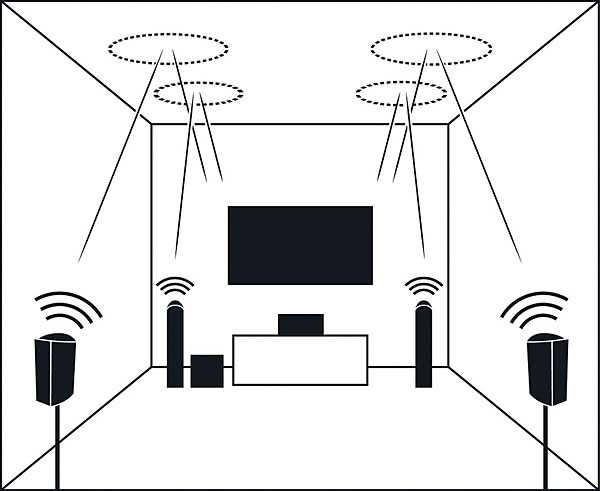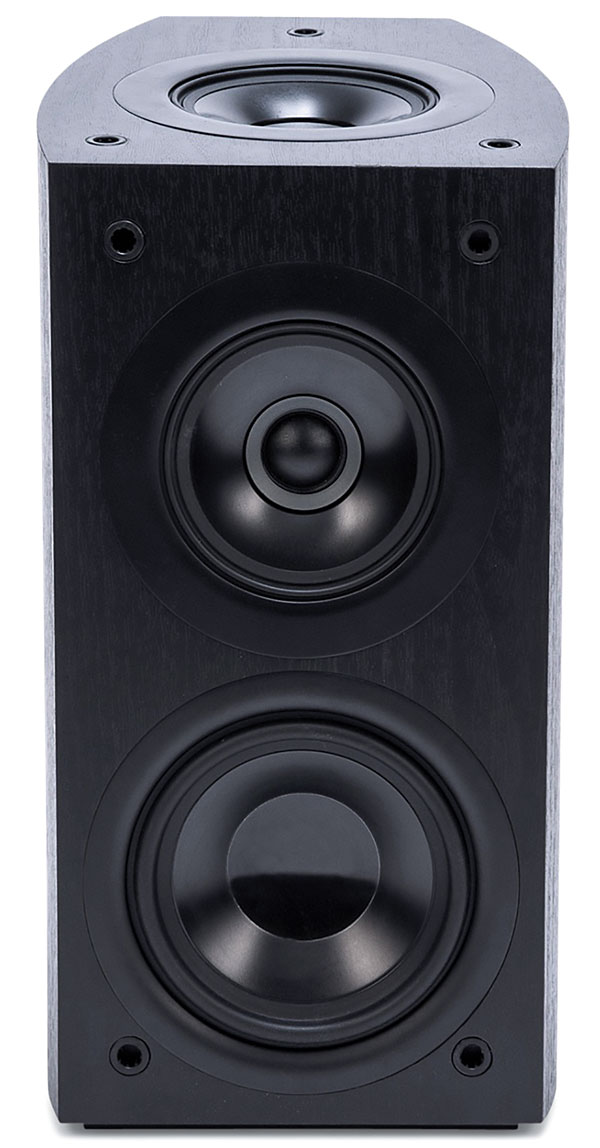Pioneer Elite SP-EBS73-LR Speaker System Review

AT A GLANCE
Plus
Dolby Atmos–enabled monitors
Laser-like focus from coaxial driver array
Minus
Just-average subwoofer performance
THE VERDICT
Andrew Jones’ excellent Atmos-enabled speakers are equally at home in a 5.1-channel footprint as they are transforming surround sound as we know it.
Dolby Atmos bids to change the landscape of surround sound at home. One thing it has already changed is my mind.
I am that 5.1 guy. I’ve spent much of my tech-writing career promoting the standard 5.1-channel speaker configuration and defending it against all comers. This has pitted me against two-channel loyalists who mistakenly believe there is no such thing as a surround audiophile. But I’ve also opposed what I deem to be useless additions to 5.1.
When Dolby Digital EX and DTS-ES made their debuts, I inveighed against surround back channels time and time again. Three speakers in front, four in back: What’s wrong with this picture? I quickly dismissed Audyssey DSX width channels because they made vocals sound processed in two-channel music. I wasn’t too enthusiastic about DSX and Dolby Pro Logic IIz height enhancement either (aside from one positive experience with a movie called The Midnight Meat Train). These faked width and height channels—with their added complications and dubious benefits—have only put potential home theater buffs off surround sound in general. The closest thing I’ve found to a worthy extension of 5.1 is 5.2—most rooms benefit from an extra sub. (Beware of marketing hype, however: the term “.2” is often used to describe a mono subwoofer channel with two outputs, which does not allow independent adjustment of each sub’s crossover points or levels within the surround processor or receiver.)
Anyway, when I tell you I’m excited about Dolby Atmos, it’s a big deal, the long-awaited rethink of a long-held position. Am I saying that 5.1 is dead? No, only that it has finally found an extension worth your time and money. The beauty of a “Dolby Atmos–enabled” system, like the one reviewed here, is that it builds on a 5.1 footprint while providing real benefits to the listener—not in the form of faked height channels, but a height layer based on discretely encoded information, enabling a movie mixer to better tell a story.
Atmos Enabled
If you’ve read our previous coverage, you already know that Dolby Atmos is an object-oriented surround technology. Unlike channel-based encoding, Atmos allows mixing engineers to place objects vertically or horizontally, with height effects that expand the hitherto flat plane of surround sound into something more akin to a domed soundfield. The first generations of Atmos speakers and receivers are now arriving. They include Atmos-enabled speakers, like this Pioneer system, which incorporate topfiring elevation drivers that bounce sound off the ceiling—a welcome alternative for the homeowner (or renter) who doesn’t want to poke holes for ceiling speakers.

Pioneer Elite’s latest speaker line is the third dreamed up by celebrity designer Andrew Jones, the first to support Atmos, and the first to feature a concentric driver array at a moderate price point. In the SP-EBS73-LR three-way monitor, a 1-inch silk-dome tweeter sits in the center of a 4-inch aluminum-cone midrange driver. This concentric array is repeated in the Atmos height drivers built into the top of the speaker. The monitor’s front baffle also includes a 5.25-inch aluminum-cone woofer, which is duplicated in the SP-EC73 center speaker (along with a 5.25-inch passive radiator) and triplicated in the floorstanding SP-EFS73 ($700/each), that last model not reviewed here.
Jones previously worked for KEF, a stronghold of concentric driver design. He refers to the tweeter-in-midrange array as a Coherent Source Transducer. “Unlike a coaxial driver,” says Pioneer’s Website, “the CST concentric design eliminates audible time domain errors that cannot be avoided when drivers are not aligned on the same axial or vertical plane.” Mediating between tweeter and midrange is a skinny waveguide, with the midrange itself serving as an extension of the waveguide. Both midrange and woofer boast “true pistonic action,” the goal of almost any transducer, for controlled response.

Jones was kind enough to set up the speakers in my home with a Pioneer Elite SC-89 receiver while I noted how the procedure differed from a 5.1 installation. The system under review included five speakers on stands, four sets of height drivers incorporated into four of those speakers, and one sub. Jones adjusted the receiver’s speaker system setting to 5.2.4 (which allows for up to two subs) and its speaker size setting to “Dolby SP.” MCACC, Pioneer’s auto setup program, chose higher levels for the elevation drivers than for their frontfiring brethren, and Jones recommends pushing them still higher.
Why? The sound from the elevation drivers has further to travel and loses some energy bouncing off of the ceiling, so they require more power to achieve the same levels as the front-firing drivers. Jones also prefers to factor in a slight additional boost for height-layer effects. So we ended up with elevation speaker settings between 1.5 and 3 decibels over the basic speaker settings. MCACC measured speaker distance for the elevation modules from drivers to ceiling to seating—in other words, including the bounce off my hard plaster ceiling—and correctly arrived at settings roughly twice the actual physical-speaker-to-seat distance. For more information, see the Atmos speaker setup guide on the Pioneer site (pioneerelectronics.com/ephox/StaticFiles/PUSA/Files/Home/DolbyAtmos-Home-Theater-Installation-Guidelines.pdf).
Per Dolby spec, the top-mount drivers in Atmos-enabled speakers are subject to a 180-hertz low-frequency cutoff. The Atmos receiver should redirect bass below that point to the front drivers, though Jones says some receivers improperly redirect bass to the sub, starving the front woofers. Also beware of receiver auto-setup programs that peg the system’s general crossover to the low-frequency limit of the elevation drivers. In this speaker system, the front drivers go much lower than 180 Hz and warrant a crossover no higher than 80 Hz, the setting used here.
On Jones’ recommendation, I left the grilles off (not my usual practice).
Associated equipment included the Pioneer Elite SC-89 Class D receiver for Atmos demos and the Pioneer Elite VSX-53 Class AB receiver—my old warhorse—for 5.1 and stereo demos. Signal sources included an Oppo BDP-83SE universal disc player, Meridian Director USB DAC, Lenovo Windows 7 laptop, Micro Seiki BL-21 turntable, Shure V15MxVR/N97XE cartridge, and the phono stage of a Denon PRA-S10 stereo preamp. All movie demos were on Blu-ray Disc.
Into Atmos
Of the two Atmos Blu-rays available for this review, the one I concentrated on was the Dolby Atmos Demonstration Disc. I also watched the first movie available to us, Transformers: Age of Extinction (see the Pioneer SC-89 receiver review for more details on that). Please note that my comments are on an Atmos-enabled speaker configuration, with a particular set of elevation module-equipped speakers, as opposed to an installation with physical speakers mounted to the ceiling. This is not the last word on object-based surround in general. Our reviewers will be probing the aesthetics of Atmos for some time to come.





























































